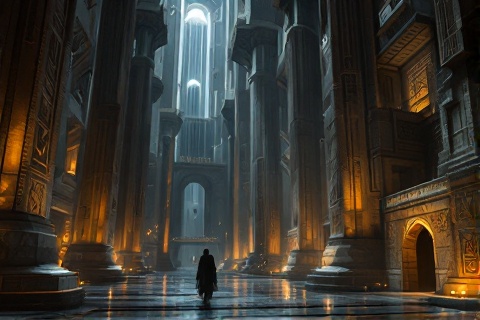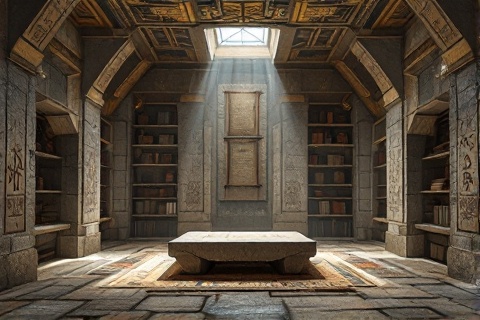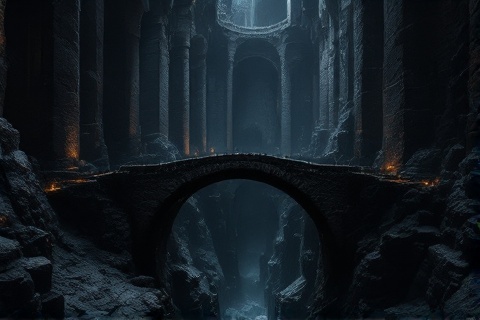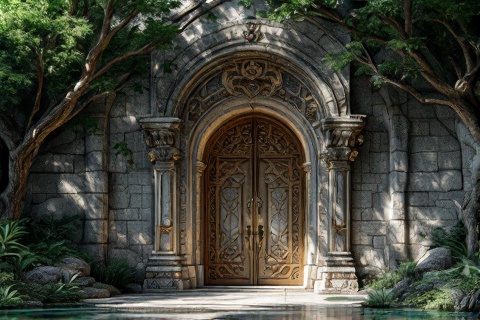
Khazad-dûm: The Shining Jewel of Dwarven Lore
Unveiling the Mysteries of Moria in Tolkien's Legendarium
The Foundation of Khazad-dûm

Khazad-dûm, the greatest of all Dwarven realms, stretched beneath three majestic
peaks of the Misty Mountains: the cruel Caradhras, the silver Celebdil, and the
cloudyhead Fanuidhol. These three mountains, known in Elvish as Barazinbar,
Zirakzigil, and Bundushathûr respectively, stood as eternal guardians of the
vast underground realm.
The founding of Khazad-dûm occurred in the First Age by Durin
I, called the Deathless, eldest of the Seven Fathers of the
Dwarves. According to ancient lore, Durin awoke at Mount
Gundabad in the far north and journeyed south until he came to Kheled-zâram, the
Mirrormere, where he saw a crown of stars reflected in its waters, taking this
as a sign to establish his kingdom.
The original settlement began in natural caverns beneath the mountains, which
the Dwarves gradually expanded through their masterful stonecraft into an
intricate network of halls, chambers, and passages. The Dwarves did not merely
carve out spaces but worked with the natural formation of the rock, creating an
architectural marvel that enhanced the mountain's natural structure while
maintaining its stability.
The Architecture of the Dwarven Realm

The architectural magnificence of Khazad-dûm manifested in its multiple levels
of halls and passages that spanned the entire width of the Misty Mountains,
connecting the eastern and western gates. These halls varied in size and
function, from intimate living quarters to grand ceremonial spaces, creating a
complete underground city that could house thousands of Dwarves.
Throughout Khazad-dûm, massive chambers were supported by pillars carved
directly from the living rock of the mountain, reaching heights that impressed
even the Elves of Eregion. These pillars were
not merely functional but served as showcases of Dwarven craftsmanship, adorned
with intricate geometric patterns and runes telling stories of their ancestors.
The different levels of Khazad-dûm were connected by an elaborate network of
stone stairs and bridges, engineered with precise mathematical calculations to
ensure stability and efficiency of movement. The craftsmanship of these
connections demonstrated the Dwarves' mastery of architecture, allowing for
smooth traffic flow between various sections of the city even during its busiest
periods.
One of the most remarkable features of Khazad-dûm was its sophisticated
ventilation system, a testament to Dwarven engineering prowess. Through
carefully designed shafts and passages, fresh air circulated throughout the
entire complex, reaching even the deepest chambers and forges, making the
underground city as comfortable as any surface dwelling.
The Chamber of Mazarbul

The Chamber of Records stood as a testament to the Dwarves' dedication to
preserving their history and knowledge. Within its walls, generations of
scholars maintained chronicles of their people's achievements, technical
drawings of their greatest works, and records of their dealings with the outside
world.
The chamber's design featured a practical yet elegant square layout with
recessed walls specifically crafted to house countless scrolls, books, and
tablets. These recesses were lined with specially treated wood to protect the
documents from the natural moisture of the mountain.
The chamber's architecture reflected the Dwarves' reverence for knowledge,
featuring magnificently preserved stone walls adorned with carved
representations of great moments in their history. The ceiling bore intricate
geometric patterns that served both as decoration and as a complex calendar
system tracking the passages of years.
The Second Hall and Bridge of Khazad-dûm

The Bridge of Khazad-dûm lay within one of the most impressive halls in the
entire realm, featuring towering black walls that stretched beyond the light of
torches into the darkness above. The hall's mighty pillars, carved with the
skill of the ancient Dwarven craftsmen, created an atmosphere of solemn grandeur
that reflected the peak of Dwarven architectural achievement.
At the heart of this great hall spanned the infamous bridge itself, an arching
span of stone that crossed a seemingly bottomless chasm. The narrow bridge,
barely wide enough for two to walk abreast, connected vital sections of the city
across a gulf so deep that none could see its bottom.
The bridge's most striking feature was its complete lack of railings or safety
barriers, embodying the Dwarves' confidence in their craftsmanship and their
sure-footedness. This design choice, while appearing perilous to outsiders,
reflected the Dwarven philosophy that their works needed no embellishment or
safeguard beyond their perfect engineering.
The Endless Stair
The Endless Stair represented one of Khazad-dûm's most ambitious architectural
achievements, connecting the lowest dungeon to the highest peak through
thousands of steps. This magnificent staircase wound its way through the very
heart of the mountain, a testament to the Dwarves' determination to master their
environment completely.
The staircase was not merely cut into the mountain but was expertly carved from
the living rock itself, ensuring its stability and longevity. The craftsmanship
displayed in its construction showed the Dwarves' ability to work with the
natural structure of the stone while creating something both beautiful and
functional.
The stairs culminated at Durin's Tower atop Celebdil, where the Dwarves could
look out over all the lands around their realm. This tower, built of
mountain-stone, served as both a watchpost and a symbol of the Dwarves' mastery
over their underground realm, connecting the depths of their mines to the very
peak of the mountain.
The Gates and Defenses

The gates of Khazad-dûm represented the pinnacle of Dwarven defensive
architecture, with the West-gate standing as the most famous example. Crafted in
cooperation with the Elves of Eregion, this gate featured the magical substance
ithildin, which revealed its decorative patterns and opening mechanism only in
starlight and moonlight when the correct words were spoken.
Throughout the complex, guard rooms and watch-posts were positioned at strategic
locations to maintain security while allowing efficient movement of defenders.
These positions were carefully chosen to provide maximum visibility while
offering protection to the guards, incorporating natural choke points in the
underground passages.
The Dwarves incorporated an intricate network of secret doors and passages
throughout Khazad-dûm, known only to the realm's defenders. These hidden routes
allowed defenders to move quickly through the city and provided escape routes if
needed, demonstrating the Dwarves' careful consideration of defensive strategy.
The natural rock formations of the mountains were enhanced and incorporated into
the defensive system of Khazad-dûm. The Dwarves strengthened existing stone
structures and created additional fortifications that blended seamlessly with
the mountain's natural architecture, making it difficult for any invader to
distinguish between natural and crafted defenses.
